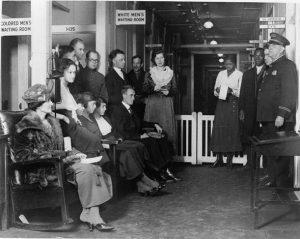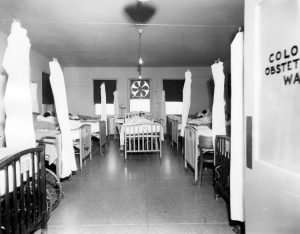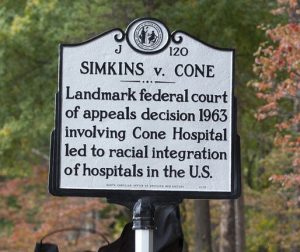By Nicolle Montes

Segregated seating area in a health care facility with a “Colored Men Waiting Room” and a “White Men Waiting Room”.
The practice of segregation in America began as early as times of slavery and became organized throughout society at the end of the Civil War. It separated the whites, and the blacks, in public facilities such as schools, stores, transportation, and even hospitals. Segregation was justified with the idea of “separate but equal”[1] but in many cases, inequality was evident when comparing separate facilities. The establishment of segregation in hospitals created limitations for health-care services, and opportunities for non-whites, and received much opposition from the civil rights movement.
Until the late 1960’s, segregation within hospitals remained legal all throughout America. Hospitals where either completely separated, with one building servicing only whites and another servicing only blacks, segregated within a building, with wards designated by race, or in rare cases, integrated completely. In a 2001 interview conducted with Thereasea Elder[2], she talks about her experiences working as a nurse in a segregated hospital. She was the first African American public health nurse in Charlotte, NC and she had the opportunity to work at Charlotte Memorial, an all-white hospital, until transferring to Good Samaritan, an all-black hospital. As Elder compares the two hospitals, she provides insight of the inequality between the two facilities, with the whites only hospital being at the advantage. She describes the extreme lack of resources at Good

An obstetric ward at the Alabama University Hospital, designated for colored patients only.
Samaritan with “a very limited supply of linen”, how there “were never enough beds” and insufficient supply of medicine. She also explains how at Charlotte Memorial “you wouldn’t have heard” of said conditions in Good Samaritan. Elder’s experiences provide support to the idea that segregated facilities were in fact unequal, and as a result, caused non-whites to receive an insufficient quality of services.
A major factor that contributed to the unequal segregation in hospitals, was the unequal allocation of funds. As expressed in Rosemary Steven’s article,[3] the modernization of hospitals within America “were the envy of the world” with improvements such as “complete air conditioning, artificial lighting systems, and adjustable electric beds” and medical advancement including “automatic X-ray processors, plastic bags for blood, and identification bracelets for patients.” However, Steven explains that “the gaps and variations” in the establishment of said amenities “were extraordinary.” Although there were major advancements made in American medicine, hospitals, particularly within poorer, predominately non-white communities, did not obtain funds necessary to implement these advancements. As a result, minorities were receiving health services of less quality as opposed to well-funded white hospitals.
In efforts to integrate, much litigation took place to challenge the practice of segregation in hospitals. Preston Reynolds, in his article[1], provides additional insight of the inequality between separated hospitals. He states that in a hospital with wards designated for black patients, and wards designated for white patients, “one could not assume that these patient areas were mirror images.” Because of the clear indication that hospitals were not run “separate but equal” as established by the Plessy v. Ferguson case in 1896, the need to challenge segregation was significant. Reynolds states that one “landmark case” was the success of Simkins v. Moses H. Cone Memorial Hospital in 1963. With major support from the NAACP and other health professionals, Simkins, an African American dentist, was able to try against Moses hospital, after they rejected the admittance of his patient in need of further medical care. The case resulted

Sign put up in honor of the Simkins v. Moses H. Cone Hospital Case of 1963.
in the desegregation of hospitals in certain states, with the justification that segregation in hospitals violates the 5th and 14th amendment. Although the case only allowed for the integration within certain states, it was still a major accomplishment in the civil rights movement, and not shortly after the Civil Rights Act of 1964 was created, which ruled segregation in public facilities unconstitutional.
Looking back at the major actions and figures in the civil rights movement, such as the Simkin v. Moses case and the NAACP, desegregation in hospitals, and society in general was a slow and highly resisted process. Until integration within hospitals was fully established, one can could expect conditions such as those explained by nurse Thereasea Elder. Seeing how non-white patients and health professionals were negatively affected due to segregation shows the importance of providing equal, and unbiased services in modern day health services.
Citations:
Primary Sources
[1] Reynolds, P Preston. “Professional and Hospital Discrimination and the US Court of Appeals Fourth Circuit 1956-1967.” American Journal of Public Health, © American Journal of Public Health 2004, May 2004, https://www.ncbi.nlm.nih.gov/pmc/articles/PMC1448322/.
Secondary Sources
[2] Clark, T. D., Clark, T. D., & University of North Carolina. (n.d.). Thereasea Delerine Elder oral history interview 2, 2001 May 9. Retrieved from https://dp.la/item/2e570b58d437ab378ce5f7f6777044b6?q=segregation nurses&subject=”African American nurses”.
[3] Stevens, R A. Health Care in the Early 1960s. 1996, https://www.ncbi.nlm.nih.gov/pmc/articles/PMC4193636/.
Images
https://weservedtoo.files.wordpress.com/2015/08/image001.jpg
https://www.nlm.nih.gov/exhibition/aframsurgeons/images/meded6.jpg
https://www.greensboromedicalsociety.com/uploads/2/2/1/6/22168606/5818d4eb0c9d2-image_1_orig.jpg